Pseudoangiomatous Stromal Hyperplasia
A 48-year-old premenopausal female presented for screening mammo. She had no history of breast or ovarian cancer
History: A 48-year-old premenopausal female presented for screening mammography. She had no personal or family history of breast or ovarian cancer. She was not on hormone therapy. She had had no prior breast or ovarian surgeries. Her past medical history was significant only for hypertension, for which she was taking lisinopril.
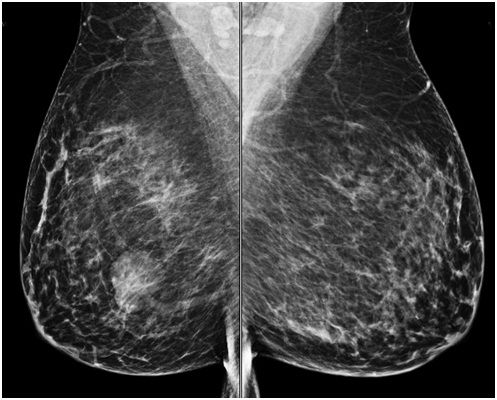
(Figure 1)
Figs. 1 and 2: Bilateral MLO and CC views of the breasts. There is an ovoid mass in the right lower, outer quadrant.
Mammogram: Her only prior mammogram was from 2002. Her mammogram at the time of presentation here demonstrated a new, lobulated, oval mass in the right lower outer quadrant measuring 5 cm x 4 cm.
Physical examination: No masses or adenopathy palpated on either side. Normalappearing skin and nipple-areolar complexes.
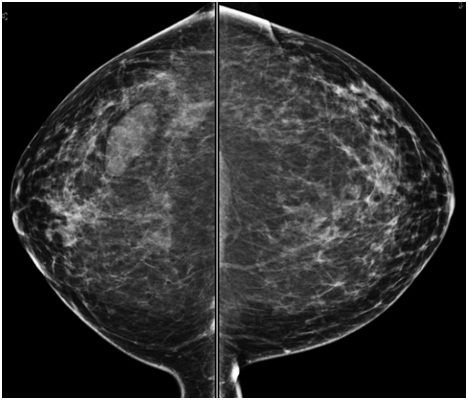
(Figure 2)
Figs. 1 and 2: Bilateral MLO and CC views of the breasts. There is an ovoid mass in the right lower, outer quadrant.
Ultrasound: A heterogeneous, lobulated 4.6 cm mass was seen at the 8:00 position of the right breast.
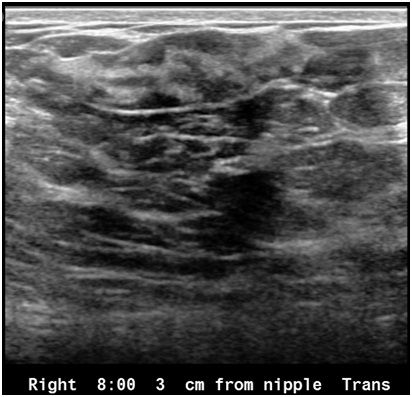
(Figure 3)
Figs. 3 and 4: Ultrasound of the right breast. There is a heterogeneous, lobulated mass at the 8:00 position of the right breast, corresponding to the mammographic abnormality.
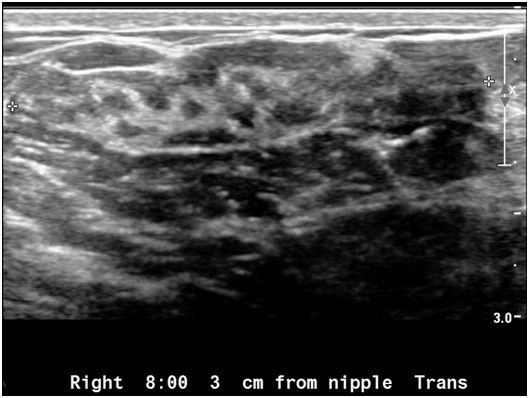
(Figure 4)
Figs. 3 and 4: Ultrasound of the right breast. There is a heterogeneous, lobulated mass at the 8:00 position of the right breast, corresponding to the mammographic abnormality.
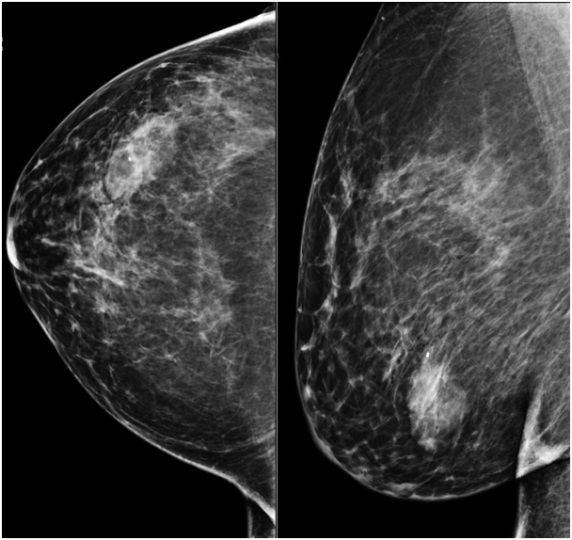
(Figure 5)
Fig. 5. Post-biopsy right mammogram. The biopsy clip is in appropriate position.
Diagnosis: Pseudoangiomatous stromal hyperplasia
Differential Diagnosis: The differential diagnosis included hamartoma, phyllodes tumor, and carcinoma (the latter considered less likely).
Biopsy: Stereotactic vacuum-assisted core biopsy was performed. The post-biopsy mammogram demonstrated the biopsy clip to be in appropriate position.
Pathology: Stromal sclerosis, mild usual ductal hyperplasia, and PASH.
Pseudoangiomatous stromal hyperplasia (PASH) is a benign breast entity first described in 1986 by Vuitchet al1.
PASH is characterized histologically by anastomosing slit-like spaces lined by spindle cells and surrounded by dense collagenous stroma. The slit-like spaces lack a true vascular lining and do not contain red blood cells2 (hence the term pseudoangiomatous). However, they may be mistaken for vascular spaces and potentially lead to a misdiagnosis of angiosarcoma1.
Grossly, PASH often forms a circumscribed, nonencapsulated mass with a tan or yellow cut surface. PASH lesions may span a wide size range, typically between 0.6 and 12 cm3.
The etiology of PASH is unknown. However, hormones are thought to promote its development, and this is supported by multiple studies. For example, PASH lesions express hormone receptors, particularly PR4. In addition, PASH most commonly manifests in premenopausal or perimenopausal women. It has been reported in the setting of postmenopausal women on hormone replacement therapy1,11 and in men with gynecomastia12, 13. Finally, there are reports of at least partial response of large or symptomatic PASH to hormonal manipulation14 or tamoxifen therapy15.
PASH commonly presents as a painless breast mass or masses (so-called tumor-forming PASH). PASH may also present as continuous breast enlargement7. PASH may be an incidental microscopic finding in up to 23 percent of breast biopsies5.
There are no pathognomonic imaging features that characterize PASH. Mammography and ultrasound typically demonstrate a well-circumscribed round or oval mass. Increased size and density of the breast over time may alternatively be seen on mammogram. PASH may be either hyper- or hypointense on both T1WI and T2WI, and may demonstrate high signal slit-like spaces on T2WI/STIR, representing the slit-like spaces found on pathologic examination. PASH typically demonstrates a type I (benign-appearing) enhancement curve8.
To date, there is one reported case suggesting malignant transformation of a PASH lesion9. In one retrospective review of 24 patients who had a diagnosis of PASH from surgical excision and/or core biopsy, one case of PASH was associated with atypical ductal hyperplasia (ADH) and two cases of PASH were associated with atypical lobular hyperplasia (ALH). In one patient, PASH was associated with multiple foci of ductal carcinoma in situ (DCIS). Three of these four patients (75 percent) had a family history of breast cancer6.
The presence of ADH, ALH and DCIS in association with PASH may be incidental, as there is evidence to support a lower risk of breast cancer in women with PASH than in those without PASH10. Based on prior studies, if PASH is diagnosed on core biopsy, surgical excision may not be necessary, and close observation with mammography to assess for interval growth is most likely sufficient. Above a lesion size greater than 2 cm, a breast surgeon recommended excision in one study; otherwise, the patient could choose between excision and observation6. It has been suggested that a lower threshold for excision of PASH may be indicated in patients with a strong family history of breast cancer6.
References
1. Vuitch MF, Rosen PP, Erlandson RA. Pseudoangiomatous hyperplasia of mammary stroma. Hum Pathol 1986; 17(2): 185-191.
2. Rosen PP, Oberman HA. Tumours of the Mammary Gland, Atlas of Tumour Pathology, AFIP Third Series, Fascicle 7, 1993.
3. Virk RK, Khan A. Pseudoangiomatous stromal hyperplasia: an overview. Arch Pathol Lab Med 2010; 134:1070-4.
4. Aljarrah A et al. Breast Pseudoangiomatous Stromal Hyperplasia Challenges. Pak J Med Sci 2012; 28:5.
5. Ibrahim RE, Sciotto CG, Weidner N. Pseudoangiomatous hyperplasia of mammary stroma. Some observations regarding its clinicopathologic spectrum. Cancer 1989;63:1154-60.
6. Bowman E et al. Pseudoangiomatous Stromal Hyperplasia (PASH) of the Breast: A Series of 24 Patients. The Breast Journal, Volume 18 Number 3, 2012 242-247.
7. Amenomori M, Hayashi T, Abe K, Itoyanagi N, Kohno S. A Case of Pseudoangiomatous Stromal Hyperplasia of the Breast Presenting with Chest Pain.The Open Breast Cancer Journal.2009; 1:10-13.
8. Solomou E. et al. A case of a giant PASH of the breast: MRI findings. Rare Tumors 2012; Volume 4:e23.
9. Seltzer MH, Kintiroglou M. Pseudoangiomatous stromal hyperplasia and response to tamoxifen therapy. Breast J 2003; 9:344.
10. Degnim AC, Frost MH, Radisky DC et al. Pseudoangiomatous stromal hyperplasia and breast cancer risk. Ann SurgOncol 2010; 17:3269-77.
11. Anderson C, Ricci A Jr, Pederson CA, Cartun RW. Immunocytochemical analysis of estrogen and progesterone receptors in benign stromal lesions of the breast.Evidence for hormonal etiology in pseudoangiomatous stromal hyperplasia of mammary stroma. Am J Surg Pathol 1991;15:145-9.
12. Badve S, Slaone JP. Pseudoangiomatous stromal hyperplasia of male breast. Histopathology 1995;26:463-6.
13. Milanezi MF, Saggioro FP, Zanati SG, Bazan R, Schmitt FC. Pseudoangiomatous stromal hyperplasia of mammary stroma associated with gynecomastia. J Clin Pathol 1998; 51:204-6.
14. Powell CM, Cranor ML, Rosen PP. Pseudoangiomatous stromal hyperplasia. A mammary stromal tumor with myofibroblastic differentiation. Am J Surg Pathol 1995; 19:270-7.
15. Pruthi S, Reynolds C, Johnson RE, Gisvold JJ. Tamoxifen in the management of pseudoangiomatous stromal hyperplasia. Breast Journal 2001;7:434-9.
Lisa M. Dias, MD, Breast Imaging Fellow, Elizabeth Wende Breast Care Center, Rochester, NY
What New Research Reveals About Novice Use of AI-Guided Cardiac Ultrasound
April 4th 2025In a study recently presented at the American College of Cardiology (ACC) conference, researchers found that novice use of AI-guided cardiac ultrasound after an AI-enabled electrocardiogram increased the positive predictive value for reduced left ventricular ejection fraction (LVEF) or aortic valve stenosis by 33 percent.
The Reading Room Podcast: Current Perspectives on the Updated Appropriate Use Criteria for Brain PET
March 18th 2025In a new podcast, Satoshi Minoshima, M.D., Ph.D., and James Williams, Ph.D., share their insights on the recently updated appropriate use criteria for amyloid PET and tau PET in patients with mild cognitive impairment.
Study with CT Data Suggests Women with PE Have More Than Triple the One-Year Mortality Rate than Men
April 3rd 2025After a multivariable assessment including age and comorbidities, women with pulmonary embolism (PE) had a 48 percent higher risk of one-year mortality than men with PE, according to a new study involving over 33,000 patients.
GE HealthCare Debuts AI-Powered Cardiac CT Device at ACC Conference
April 1st 2025Featuring enhanced low-dose image quality with motion-free images, the Revolution Vibe CT system reportedly facilitates improved diagnostic clarity for patients with conditions ranging from in-stent restenosis to atrial fibrillation.